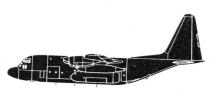
ASN Wikibase Occurrence # 320209
| Date: | Friday 2 October 2015 |
| Time: | 00:19 |
| Type: |  Lockheed C-130J-30 Super Hercules |
| Owner/operator: | United States Air Force - USAF |
| Registration: | 08-3174 |
| MSN: | 5648 |
| Year of manufacture: | 2011 |
| Total airframe hrs: | 2551 hours |
| Engine model: | Allison AE2100D3 |
| Fatalities: | Fatalities: 11 / Occupants: 11 |
| Other fatalities: | 3 |
| Aircraft damage: | Destroyed, written off |
| Category: | Accident |
| Location: | Jalalabad Airport (JAA) -
 Afghanistan Afghanistan
|
| Phase: | Take off |
| Nature: | Military |
| Departure airport: | Jalalabad Airport (JAA/OAJL) |
| Bagram Air Base (OAI/OAIX) | |
| Investigating agency: | USAF AIB |
| Confidence Rating: |
A Lockheed C-130J Hercules operated by the United States Air Force crashed at Jalalabad Airport, Afghanistan.
The 11 occupants of the aircraft, six U.S. service members and five civilians, were killed, along with three persons on the ground.
The plane was assigned to the 774th Expeditionary Airlift Squadron, part of the 455th Air Expeditionary Wing.
The crew flew a successful mission from Bagram Airfield, Afghanistan, to Jalalabad Airfield. While conducting engine running on-load/offload operations at Jalalabad Airfield, the pilot raised the elevators mounted to the horizontal stabilizer by pulling back on the yoke. This provided additional clearance to assist with offloading tall cargo. After a period of time in which the pilot held the yoke by hand, he placed a hard-shell night vision goggle (NVG) case in front of the yoke to hold the elevator in a raised position.
However, because the pilots were operating in darkened nighttime flying conditions and wearing NVGs, neither pilot recognized and removed the NVG case after loading operations were complete or during takeoff. Once airborne, the aircraft increased in an excessive upward pitch during the takeoff climb. The co-pilot misidentified the flight control problem as a trim malfunction, resulting in improper recovery techniques. The rapid increase in pitch angle resulted in a stall from which the pilots were unable to recover. The aircraft impacted approximately 28 seconds after liftoff, right of the runway, within the confines of Jalalabad Airfield.
The aircraft struck the ground, a perimeter wall and a guard tower, which resulted in all personnel onboard the aircraft being killed, along with three Afghan Special Reaction Force (ASRF) members assigned to the tower.
CONCLUSION:
I find by the preponderance of the evidence that the cause of the mishap was pilot error due to the combination of the MPs [ mishap pilot] decision to place the hard-shell NVG case forward of the yoke blocking the flight controls, the distractions experienced by the MP and MCP [mishap co pilot] during the course of the ERO [Engine Running Onload/Offload], and the misidentification of the malfunction once airborne resulting in the destruction of the aircraft and cargo and the loss of fourteen lives. I also find, by a preponderance of the evidence, environmental conditions, inaccurate expectations, and fixation substantially contributed to the mishap.
Accident investigation:
 |
|
Sources:
Bob Daley
455th Air Expeditionary Wing
Location
Images:

photo (c) Robert Frola; Avalon Airport, VIC (AVV/YMAV); 02 March 2011
Revision history:
| Date/time | Contributor | Updates |
|---|
The Aviation Safety Network is an exclusive service provided by:


 ©2024 Flight Safety Foundation
©2024 Flight Safety Foundation